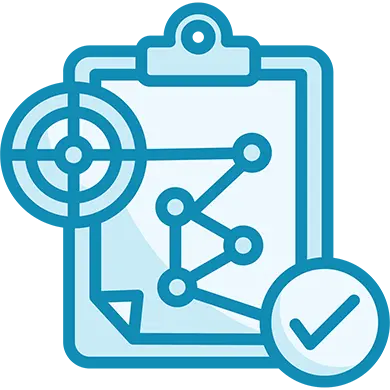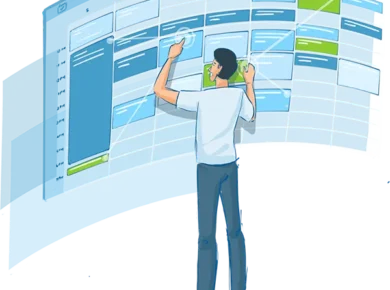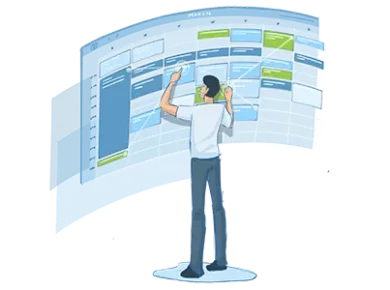CCPM or Critical Chain Project Management has developed as a response to poorly performing projects. The issues considered include: outdated deadlines, frequently missed, with the increased costs in addition to the allocated budget.Some of the main conditions necessary for an efficient implementation of a project are:
- the correct estimation of the duration of activities
- resources availability – the conflict must be eliminated between the activities that are carried out at the same time and the limited resources
CCPM or Critical Chain Project Management brings together the long periods of safety assigned to activities in buffer reserves to protect delivery times and to avoid wasting this safety time through:
- poorly synchronized integration of activities components of the project
- Parkinson’s law – which refers to the fact that the execution of a task will extend over the entire time available, even if it is more than necessary.
- Student syndrome refers to the planned postponement. That means, with the risk of eliminating safety margins, that the start of the execution of a task is made at the last possible moment before the deadline.
- Inefficient multitasking which is known to reduce efficiency and performance because the majority of people can only focus on one thing at a time
CCPM or Critical Chain Project Management method development
The notion and idea of CCPM or Critical Chain Project Management was developed by Eliyahu Moshe Goldratt (March 31, 1947 – June 11, 2011) and was introduced in 1997 in his book Critical Chain. The book is actually teaching how to apply the Theory of Constraints (TOC) to project management.

In CCPM or Critical Chain Project Management are applied the TOC concepts to project management. First of all, the purpose of the whole system must be identified and in Critical Chain on-time performance is the primary goal when applied to one single project. If Critical Chain is applied to a multi-project then the main goal will be the throughput of the total system.
Focusing steps in TOC – Theory of Constraints, applied to project management
- Identify the constraint that limits system performanceSingle projectMulti-projectThe critical chainThe bottleneck resources that involve most cross-project utilization
- Exploit the existing resources to improve performanceSingle projectMulti-projectEnsure that the activities in the critical chain are performed efficiently and there are no delaysManaging the deployment of the critical resources by prioritizing projects and avoiding multitasking
- Subordinate the non-bottleneck resources to improve the performance of the bottleneck resourceSingle projectMulti-projectCritical activities from the critical chain must not be delayed or affected by non-critical activitiesEnsure a high utilization of the bottleneck resources, including when this means that non-critical resources are left inactive.
- Elevate the capacity of the total system focusing first on the bottleneck constraintSingle projectMulti-projectInvestment in additional resourcesInvestment in additional resources
- Repeat to prevent inertia to become a new constraint
The main conceptual elements of CCPM or Critical Chain Project Management
1. Project planning
in this stage, the project is divided into tasks and each one is allocated a time interval and the necessary resources. The sequence of tasks that leads from the beginning to the end of the project and which is the longest in terms of resources is identified as the critical chain.
In Critical Chain Project Management, 50% of the estimated time is taken into account. For tasks that have the highest probability of not being completed on time, “buffers” are used. These are additional time intervals that together set a more plausible delivery date for the whole project. On average, these time buffers represent ⅓ the entire duration of the project. The difference between the time that includes the safety buffer and that 50 % of the initial estimate is the project deadline.There are 4 types of Buffer that are used in Critical Chain Project Management:
- Project Buffer – between the last task and the completion date to protect the project completion date
- Feeding Buffer – between the last task on a non-critical chain and the critical chain. It protect the latter from any delays from the non-critical chain
- Resource Buffer – to ensure the existence of critical resources on the Critical Chain
- Capacity Buffer – on-call resources necessary in case unforeseen issues
2. Project execution
at this stage, all planning data is included in a chart called the fever chart. On the horizontal line is shown the time interval allocated to the project and the vertical line represents the time buffer. The latter is represented graphically in 3 colors, namely:
Green is what shows us that the execution of the tasks was within the set time frame and if it continues in the same way the project can be finished just before the set deadline
Yellow, which shows that in the execution of the tasks the allotted time has been slightly exceeded and measures should be taken to correct this fact or the execution of the project will slightly exceed the deadline
Red, which shows that the time buffer has been exceeded and corrective action is required to return to the established schedule and respect the projects deadline
To eliminate inefficient multitasking and to overcome Student’s syndrome and Parkinson’s Law, each task is executed as quickly as possible, however without starting one if the previous one is not yet completed. Buffer consumption is monitored daily so recovery action may be taken where necessary.
3. Continuous improvement and monitoring
Because the initial planning of each task is estimated, the execution of each task is not followed in the planned time, but rather in the shortest possible time. At the same time, the existing time buffer is kept very carefully under control.





